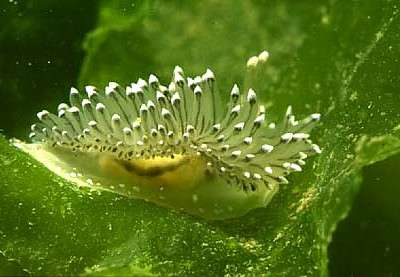
Janolus cristatus
(delle Chiaje, 1841)
Order: NUDIBRANCHIA
Suborder: ARMININA
Family: Zephyrinidae
DISTRIBUTION
Northeastern Atlantic from Norway to Morocco, and western Mediterranean.
PHOTO
Oosterschelde, Goese Sas, the Netherlands. Depth 5 meters. PHOTO: René Lipmann.
Grows to75mm in length. Feeds on erect bryozoans such as Bugula. Although species of Janolus look very like aeolids, there is no close relationship. In this species, with transparent cerata, a digestive gland duct can be clearly seen running to the ceratal tip where it divides into a number of terminal branches. Unlike aeolids, there are no terminal cnidosacs, and the cerata form a fringe around the anterior edge of the mantle. The anus also opens in the dorsal midline in the posterior half of the body, where in aeolids it opens in the right anterior quarter, usually on the side of the body.
Reference:
• Delle Chiaje, S. (1841). Descrizione e notomia degli animali invertebrati della Sicilia citeriore osservati vivi negli anni 1822-1830, Napoli, 7: pls. 86-173 (Nudibranchia pls. 88, 89, 100, 106, 178). Text in vol. 8, p. 6 (1844)
Rudman, W.B., 1999 (September 2) Janolus cristatus (delle Chiaje, 1841). [In] Sea Slug Forum. Australian Museum, Sydney. Available from http://www.seaslugforum.net/find/janocris
Related messages
Re: Janolus cristatus from Mediterranean
March 17, 2009
From: Petros Ornithopoulos
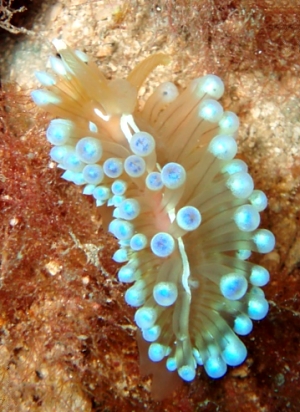
Concerning message #20425:
Here is Janolus cristatus from Greece
Locality: ,"Valitsa" dive site, Kassandra penisula, Chalkidiki, 16m, Greece, Nthn Aegean Sea, Mediteranean, 08 March 2009. Photographer: Petros Ornithopoulos.
Petros Ornithopoulos.
petros_ornithopoulos@yahoo.gr
Petros Ornithopoulos, 2009 (Mar 17) Re: Janolus cristatus from Mediterranean. [Message in] Sea Slug Forum. Australian Museum, Sydney. Available from http://www.seaslugforum.net/find/22327Thanks Petros,
Best wishes,
Bill Rudman
Re: Janolus cristatus from Mediterranean
August 13, 2007
From: Raphaël Vallotton
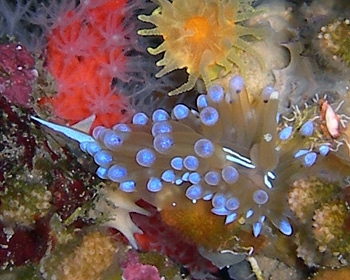
Concerning message #20026:
Dear Dominique, dear Bill,
I've just taken a picture of an "unidentified" nudibranch. It seems to be a Janolus cristatus too. Compared to the first picture of Dominique, one can see the same pale orange body and the blue extremities. Moreover, it has the same two white lines on the top of the body.
I didn't found any other Janolus during the dive, same colour or another.
The pictures were shot during a dive called "La Pierre à Mouret", south of Les Embiez (France) at approximately 32m on 5th august 2007 (~9:30am) departing from Sanary-sur-Mer with the Club de Plongée de Sanary (www.sanary-plongee.com ).
Locality: La Pierre à Mouret, 32m, Les Embiez (France), Mediterranean Sea, 05 August 2007. Length: approx. 30mm. Photographer: Raphaël Vallotton.
Thanks for sharing your shots.
Best regards.
Raphaël
betxen@hotmail.com
Vallotton, R., 2007 (Aug 13) Re: Janolus cristatus from Mediterranean. [Message in] Sea Slug Forum. Australian Museum, Sydney. Available from http://www.seaslugforum.net/find/20425Dear Raphaël,
Yes this is J. cristatus.
Best wishes,
Bill Rudman
Eggs of Janolus cristatus
July 18, 2007
From: Richard Lord
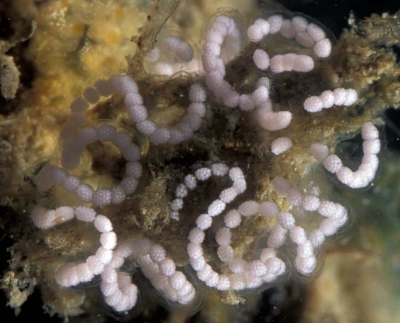
Dear Bill:
In your reply to message #14537 regarding the identification of Janolus cristatus eggs you write "If you have a look at an earlier message[#1285], there is a photo of its egg ribbon, and although it has the same general shape, the individual eggs are relatively large and form a single row in the ribbon. In your egg ribbon the eggs are small and are in a multiple arrangement."
You will see in my photo here that Janolus cristatus eggs are not in a single row in the ribbon. I believe each 'pearl' in the ribbon is made up of numerous eggs. The eggs in the attached image were found by a pontoon in the Queen Elizabeth II marina in St. Peter Port harbour, Guernsey, Channel Islands.
Locality: Queen Elizabeth II marina, 10 cm, Guernsey, Great Britain, English Channel, Atlantic, 3 September 2005, marina pontoon. Length: 1 cm. Photographer: Richard Lord.
Best wishes,
Richard Lord
fishinfo@guernsey.net
Lord, R., 2007 (Jul 18) Eggs of Janolus cristatus. [Message in] Sea Slug Forum. Australian Museum, Sydney. Available from http://www.seaslugforum.net/find/20089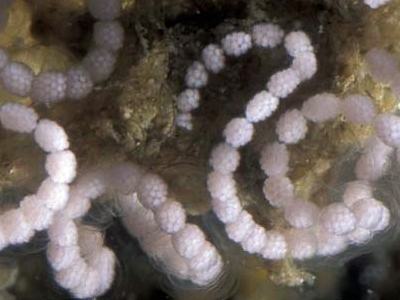
Dear Richard,
Thanks for the photo. You are of course quite right - I note in Thompson & Brown (1984) that Hecht back in 1895 thought that they were single eggs but Pelseneer (1935) noted that there could be up to 250 eggs in each of these egg-like capsules. My mistake in just looking at the photo and not checking.
-
Thompson, T.E. & Brown, G.H. (1984) Biology of Opisthobranch Molluscs, Vol 2. Ray Society: London.
Best wishes,
Bill Rudman
Janolus cristatus from Mediterranean
June 26, 2007
From: Dominique Horst
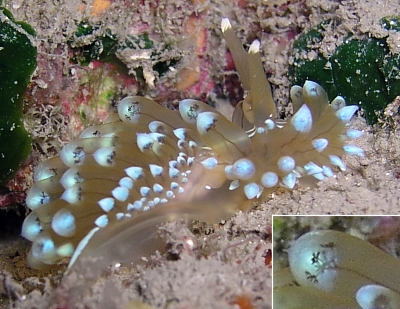
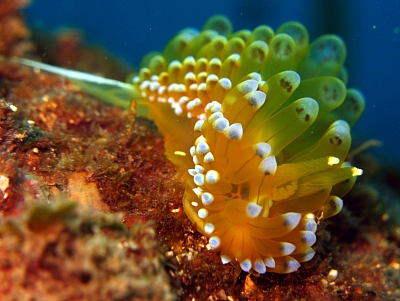
Hello Bill,
We've only met this beauty a few times and I find it hard not to share these shots on the forum. We find both version of colours, blue-grey and yellow-orange. Could this difference be explained by juvenile vs adult ? The blue-white is smaller.
Or food can be responsible of the coloration ?
Locality: Cap d'Antibes and Lerins Island, 18 m, France, Mediterranean sea, 24/04/2007. Length: 20 to 30mm. Photographers: Elisabeth Juan (upper photo) Dominique Horst (lower photos).
Kind regards,
Dominique
dominique.horst@wanadoo.fr
Horst, D., 2007 (Jun 26) Janolus cristatus from Mediterranean. [Message in] Sea Slug Forum. Australian Museum, Sydney. Available from http://www.seaslugforum.net/find/20026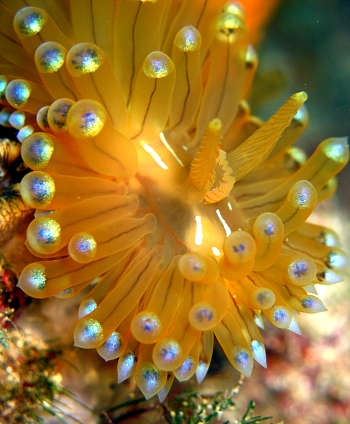
Dear Dom,
I am not sure if anyone has studied the colour differences in this species. It could well be to do with food pigmentation. The pale animal allows us a superb view of the fine branching of the digestive gland at the tip of the cerata, and your head photo laongside shows the crest or caruncle between the rhinophores very well.
Best wishes,
Bill Rudman
Cannibalism? with Janolus cristatus
March 27, 2007
From: Mat Vestjens
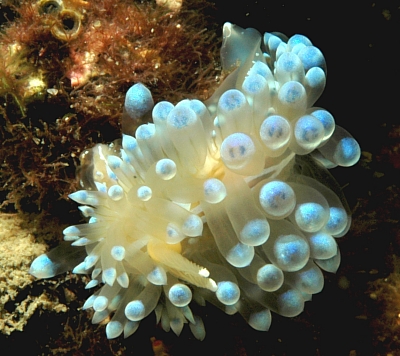
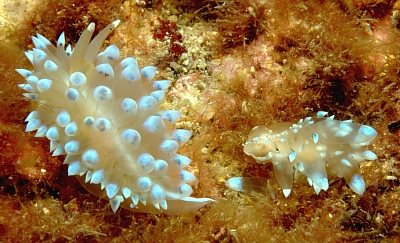
Hello Bill,
Two weeks ago I observed something very interesting. I found a strangely curled specimen of Janolus cristatus. At first I could not tell head from tail and tried to make some shots to sort it out later (picture 1). Then the larger part of the entanglement moved on and a smaller part stayed in position (picture 2). My first thought was that a small and a big specimen had been mating, but after looking closely, the smaller part did not have a head (picture 3). Is cannibalism known from J. cristatus? As far as I know, they feed on bryozoans.
Locality: Selce, 12 metres, Croatia, Adriatic, 15 March 2007, Subtidal, rocky. Length: 30 mm. Photographer: Mat Vestjens.
Best regards,
Mat Vestjens
annenmat@natuurlijkmooi.net
Vestjens, M.G., 2007 (Mar 27) Cannibalism? with Janolus cristatus. [Message in] Sea Slug Forum. Australian Museum, Sydney. Available from http://www.seaslugforum.net/find/19767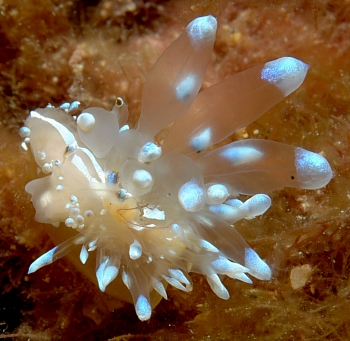
Dear Mat,
Most nudibranchs have teeth and mouth parts specialised for feeding on their normal food so I don't know if the teeth of a bryozoan feeder would be very good at eating a nudibranch body. Also, looking at the damaged animal, there seems to be a series of small bud-like cerata around the edge of the damaged region which would suggest regrowth is beginning to take place. If so, it would mean the damage was not caused while you were watching. My guess would be that the healthy animal was passing by and was attracted to the other animal by normal chemical communication - and then moved on. I very much doubt it was having a bite of the damaged animal - but I could be wrong.
Best wishes,
Bill Rudman
Janolus cristatus from Portugal
July 19, 2006
From: Carlos Marreiros
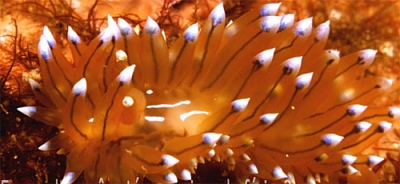
This specimen has been seen in Sesimbra, Portugal during a photo contest. Is it possible to identify it?
Locality: Sesimbra, Portugal, Atlantic, May 2006. Photographer: Filomena Sá Pinto.
Carlos Marreiros
c.marreiros@portisub.com
Marreiros, C., 2006 (Jul 19) Janolus cristatus from Portugal. [Message in] Sea Slug Forum. Australian Museum, Sydney. Available from http://www.seaslugforum.net/find/17151Dear Carlos,
This is Janolus cristatus a fairly distinctive nudibranch. Have a look at the Fact Sheet and attached messages for further information
Best wishes,
Bill Rudman
Janolus cristatus from Cyprus
May 19, 2006
From: Vasilis Athanasopoulos
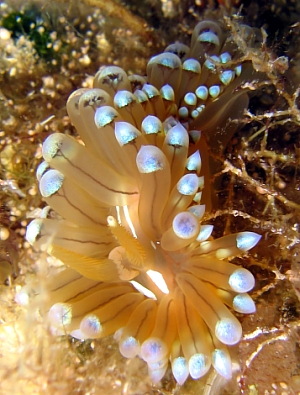
Hi Bill,
Here is a Janolus cristatus from Cyprus, Agioi Anargyroi. It seems that this is the most easterly record of this species in the Mediterranean, in the Sea Slug Forum at least. Cape Gkreko is more to the east (a little further east than 34°) than Fethiye Bay, Turkey (at about 28°30').
Locality: Agioi Anargyroi, Cape Gkreko, 10m, Cyprus, Mediterranean, 09 April 2006, algae covered rocks. Length: 5cm. Photographer: Vasilis Athanasopoulos.
Vasilis Athanasopoulos.
biotechmail@gmail.com
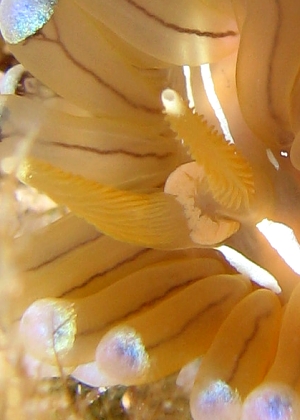
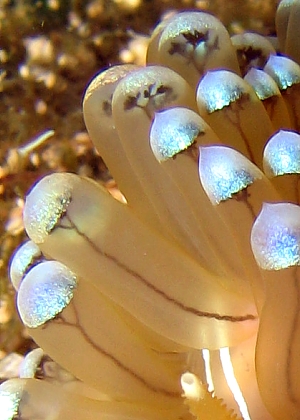
Dear Vasilis,
Thanks for the record and the nice photo. Geographic distributions are as much a record of where people have looked as they are a record of where animals live. I would expect this species to be widespread throughout the Mediterranean.- but it is nice to fill in the remaining gaps.
I have included close-ups to show the strange warty glandular lump between the rhinophores which is called the caruncle [lower left] and two show the narrow digestive gland duct which runs almost to the tip of each ceras before branching [lower right].-
Best wishes,
Bill Rudman
Janolus cristatus from Italy
April 26, 2006
From: Luigi Montevecchi
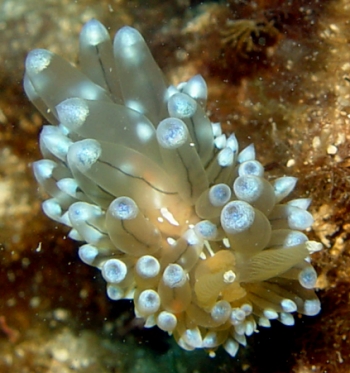
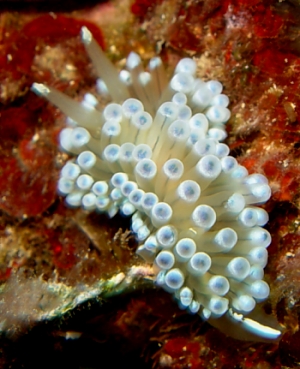
Dear Bill,
Here are some pictures of Janolus cristatus from Tremiti Islands, Italy. The water temperature varied from 11 to 12 °C. I am not sure that the filaments are the egg of the nudibranch: what do you think about?
Locality: Tremiti Islands, 10-23 meters, Italy, Mediterranean sea, 16 and 17 April 2006, Rocky. Length: 20 mm about. Photographer: Luigi Montevecchi.
Luigi Montevecchi
montevecchi@iol.it
Montevecchi, L., 2006 (Apr 26) Janolus cristatus from Italy. [Message in] Sea Slug Forum. Australian Museum, Sydney. Available from http://www.seaslugforum.net/find/16421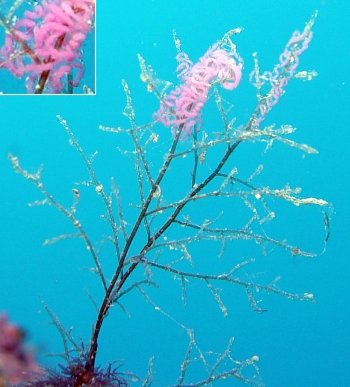
Thanks Luigi,
Fortunately I can definitely say the egg ribbon does not belong to this species. If you look at message #1285 you can see the very distinctive egg ribbon of J. cristatus. The pinkish egg ribbon in your photo is on the remains of a hydroid colony so I suspect it is the eggs of an aeolid, probably something like Flabellina affinis.
Best wishes,
Bill Rudman
Re: Janolus cristatus from Portugal
January 13, 2006
From: David Abecasis
Concerning message #15531:
Hi Bill,
Just to confirm you that the nudi seems to be crawling towards a bryozoan of the species Pentapora foliacea.
Thanks again,
David Abecasis
dabecassis@ualg.pt
Abecasis, D, 2006 (Jan 13) Re: Janolus cristatus from Portugal. [Message in] Sea Slug Forum. Australian Museum, Sydney. Available from http://www.seaslugforum.net/find/15545Thanks David,
Bill Rudman
Janolus cristatus from Portugal
January 12, 2006
From: David Abecasis
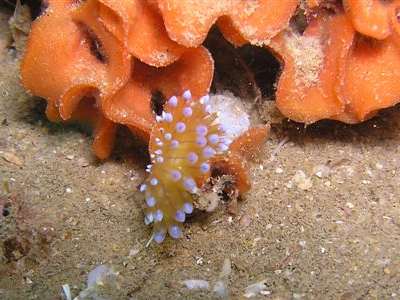
Dear Dr. Bill,
I know that unfortunately you are not receiving any messages anyway I had just come out of the water and I was very excited with the photos I have taken of this nudibranch so I'll try my luck. I have been looking around in some books and at your site but I couldn't confirm anything. I think that it might be a Zephyrinidae.
PS: these photos were taken at the Algarve (South Portugal) at a depth of 13 meters. It was on a rocky bottom covered with a fine sand. 20 December 2005
Thanks,
David Abecasis
dabecassis@ualg.pt
Abecasis, D., 2006 (Jan 12) Janolus cristatus from Portugal. [Message in] Sea Slug Forum. Australian Museum, Sydney. Available from http://www.seaslugforum.net/find/15531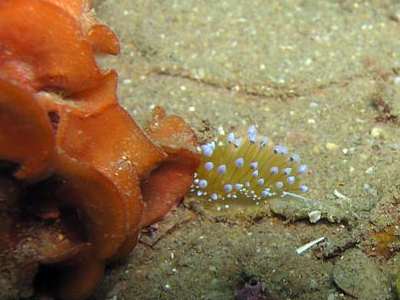
Dear David,
Sorry I couldn't answer before Christmas but the site was 'in pieces'. This nice little animal is certainly a zephyrinid and almost certainly Janolus cristatus. There are not that many zephyrinids known from that part of the world and the branching digestive gland at the tips of the cerata which I can see in the photo alongside would seem to confirm its identity.
I am not sure but the bright orange colony the Janolus is crawling on appears to be a bryozoan colony, and so I assume it is most probably a bryozoan that this Janolus feeds on.
Best wishes,
Bill Rudman
Janolus cristatus from Cornwall, UK
November 3, 2005
From: Judith Oakley
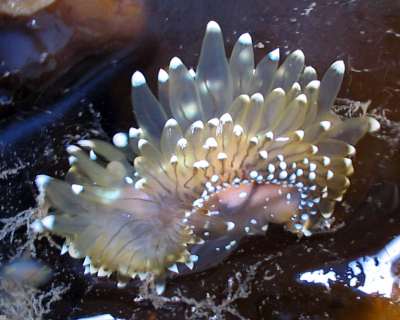
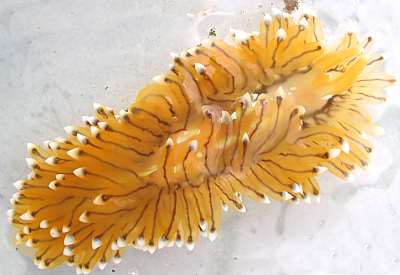
Dear Bill,
These two colourful specimens were found on a marine pontoon in Falmouth, Cornwall, UK. This is the first time that I have come across the species and I was amazed by the colourful spots on the sides of the foot.
Locality: Falmouth Marina, Cornwall, UK. Length: 45 mm. 26 October 2005. On marina pontoon . Photographer: Judith Oakley
They were located amongst bryozoans growing on kelp.
Judith
jomoakley@btinternet.com
Oakley, J.A., 2005 (Nov 3) Janolus cristatus from Cornwall, UK. [Message in] Sea Slug Forum. Australian Museum, Sydney. Available from http://www.seaslugforum.net/find/15138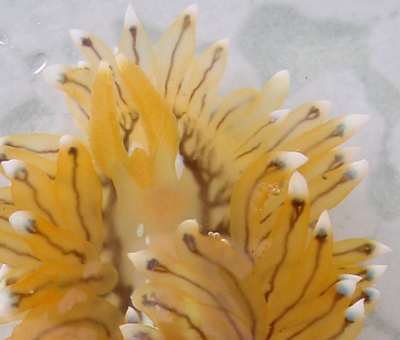
Dear Judith,
You are certainly finding a good selection of nudibranchs in this habitat. As would be expected most feed on fouling organisms such as bryozoans and ascidians. I have included a close-up alongside of the head region to show the raised 'common trunk' region of the rhinophores, with the wrinkled caruncle, which is a unique character for the genus, between the rhinophores.
Best wishes,
Bill Rudman
Janolus cristatus from Fethiye Bay, Turkey
July 14, 2004
From: Ant Turkmen
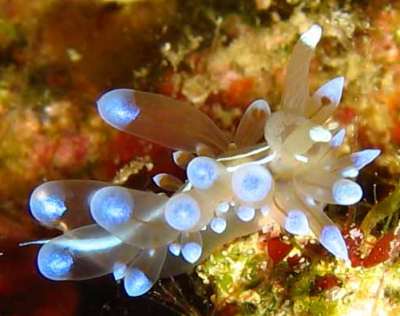
Dear Bill,
I think this is a juvenile form of Janolus cristatus.
Fethiye Bay, Turkey
Date: 28 March 2004
Depth: 18 m
Ant Turkmen
antturkmen@superonline.com
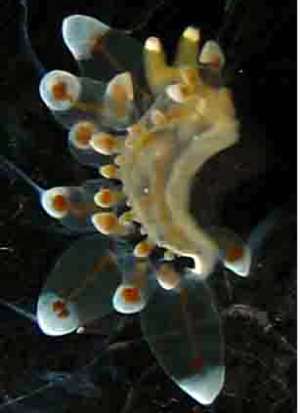
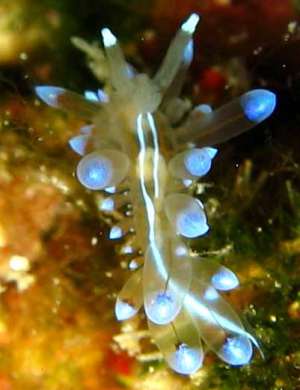
Thanks Ant,
I am not sure how far east in the Mediterranean this species has been recorded, but all records from Turkey are valuable additions to our knowledge.
Best wishes
Bill Rudman
Janolus cristatus from Tunisia
May 2, 2003
From: Anis
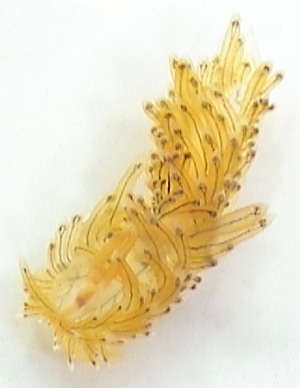
Dear Bill,
I found this sea slug in a coastal lagoon, "Lac de Tunis" in Tunis, Tunisia, North Africa. Depth: 0 to 1m some time between January and March, 2003.
Can you identify it please.
Thanks,
Anis.
Dear Anis,
I think this is Janolus cristatus. Usually there is a broad bluish-white subapical band on the cerata, but I guess I an't see it in your photos because of the white background.
[Thanks for sending me another email address. Unfortunately it does not work either. Don't send another address to the website, try sending me an email message directly to billr@seaslugforum.net then hopefully I can automatically reply]
Best wishes,
Bill Rudman
Janolus cristatus from Scotland
September 4, 2002
From: Jim Anderson
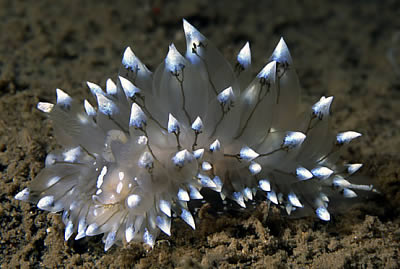
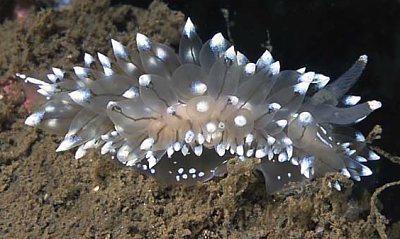
Dear Bill,
The attached two animals were found about 75 mm apart during a day dive on 4 August, 2002. Although not uncommon this is the first time I have seen this species in this particular loch.
Size: 35mm approx
Depth: 12 metres
Temp: 13 deg C
Dive Site: Lochside Cottages, Ballachulish, Loch Leven, Scotland.
Regards,
Jim A
jander4454@aol.com
Anderson, J., 2002 (Sep 4) Janolus cristatus from Scotland. [Message in] Sea Slug Forum. Australian Museum, Sydney. Available from http://www.seaslugforum.net/find/7790Thanks Jim,
The branching of the terminal end of the digestive gland duct is very clear in these photos
Best wishes,
Bill Rudman
Janolus cristatus from Mediterranean
September 4, 1999
From: Erwin Koehler
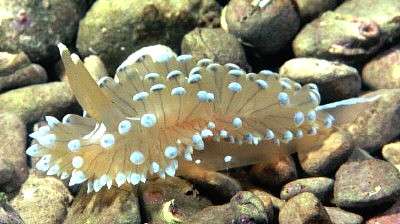
Bill
Janolus cristatus (delle Chiaje, 1841) from the Mediterranean looks a little bit different. Size ~6-7cm, depth 14 m, date: March 09, 1998, Croatia, Moscenicka Draga, divesite "Villa Istra"
Erwin
Medslugs.Koehler@t-online.de
Koehler, E., 1999 (Sep 4) Janolus cristatus from Mediterranean. [Message in] Sea Slug Forum. Australian Museum, Sydney. Available from http://www.seaslugforum.net/find/1298Janolus cristatus from the Netherlands
September 3, 1999
From: René Lipmann

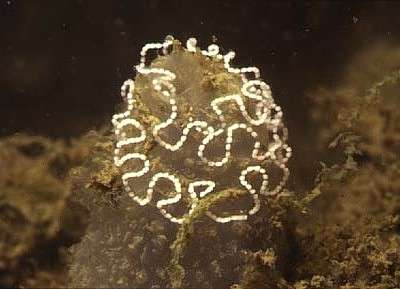
Bill,
as promised two images of the Janolus cristatus, one is a image of the eggs.
Found in the Oosterschelde, Goese Sas, the Netherlands. Depth 5 meters.
Goese Sas is a great place for slug. You have already seen pictures taken there of
the Dendronotus and the Thecacera.
Greetings
René Lipmann
Diveteam Manta,
Amsterdam
lipmann@bvd.nl
Lipmann, R., 1999 (Sep 3) Janolus cristatus from the Netherlands. [Message in] Sea Slug Forum. Australian Museum, Sydney. Available from http://www.seaslugforum.net/find/1285Dear René,
What a spectacular shot of the egg ribbon. In the photo of the animal you can see how the dark digestive gland duct in the cerata branches near the tip. Branching near the tip, like this, is quite characteristic of Janolus. In aeolids, which have similarly shaped cerata, containing a duct of the digestive gland, the duct is either never branched, or in some special cases, such as the genus Phyllodesmium, the duct is branched along its whole length.
Bill Rudman.
Rudman, W.B., 1999 (Sep 3). Comment on Janolus cristatus from the Netherlands by René Lipmann. [Message in] Sea Slug Forum. Australian Museum, Sydney. Available from http://www.seaslugforum.net/find/1285